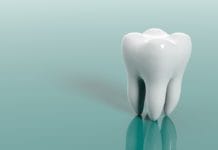If you use social media, you are fully aware of the vanity that we pour into our looks. Some of us are so self-conscious that we use photo filters to smooth our skin and give our appearance an airbrushed look. Therefore, when a recent study performed by Mintel/Greenfield Online revealed that 67% of Americans had whitened their teeth, it came as no surprise.1
Look not at me to cast out shame, for I am as guilty as the next and feel that whiter teeth can help instill confidence in a person’s smile.
History of Teeth Whitening
How did we get here? While many attempted to whiten their teeth using various methods, teeth whitening did not officially hit the consumer market until the 1980s. During the 1960s, peroxide was used as an oral antiseptic gel to treat gingival tissue. When the gel came in contact with the enamel, it was discovered that the surface was whitened after a patient was asked to use an overnight soak of carbamide peroxide for gingival health.3
This discovery eventually led to the use of peroxide gels to achieve whiter teeth. Prior to this, teeth whitening was achieved through various methods:2-4
- Ancient Egyptians used a paste comprised of ground pumice stone, white vinegar, and ground oxen hooves in an attempt to whiten their teeth.
- Ancient Romans used urine to whiten their teeth because of the ammonia it contains.
- In the 17th century, barbers would apply nitric acid to the teeth to lighten the color.
- In the late 1800s, chlorine was a popular method of teeth whitening.
Teeth Whitening Today
The active ingredient in most teeth-whitening agents today is peroxide, which is delivered as either hydrogen peroxide (HP) or carbamide peroxide (CP). Both agents work to oxidize the chromogens ‒ or darker shades of the tooth ‒ by relying on free radicals to produce a lighter shade.5 Carbamide peroxide is an adduct of hydrogen peroxide; in other words, it is a stable complex that breaks down in contact with water to release hydrogen peroxide.5 Therefore, almost all whitening agents contain hydrogen peroxide.
These agents can be found in multiple delivery methods, including in-office whitening, take-home custom trays, whitening strips, prefabricated trays, pens, and pastes. Unfortunately, peroxide-based whitening agents have been known to create reversible pulpitis or tooth sensitivity.7
High concentrations of hydrogen peroxide whitening agents can also lead to organic matrix damage within the tooth.7 Similarly, high doses of carbamide peroxide can lead to surface enamel damage.7 The oral mucosa is also subject to irritation or burns when in contact with peroxide-based agents. Risks increase with the concentration of the administered dose.
A newer agent, phthalimidoperoxycaproic acid (PAP), is making its debut and has also shown positive results in whitening tooth enamel. PAP is a non-peroxide-based solution that has shown to be just as effective as peroxide-based products.6 This organic peroxy acid is used as a bleaching activator in laundry detergents, and thus the idea to use it as a teeth whitener was born.
However, some studies initially reported that PAP could equally cause enamel surface damage. After this conclusion, nano-hydroxyapatite was added to the formula to prevent mineral loss, resulting in zero nanoscale roughness of the enamel; thus, PAP+ was born. During the oxidation process of whitening, no reactive oxygen species (ROS) or free radicals were formed when using PAP+, which is important as free radicals are believed to be the causative factor of sensitivity during conventional HP and CP whitening.8
The new formula of PAP+ also consists of potassium citrate to assist in desensitizing exposed dentin. Potassium citrate also serves to maintain the pH level of the oral mucosa. PAP+ is a quick-acting whitening formula that does not irritate the surrounding soft tissues. Accordingly, barriers are not required when used in an office setting.
Hydrogen Peroxide vs. PAP+
While both peroxide and PAP+ are effective in whitening teeth, some studies reveal that PAP+ is superior to HP. PAP+ has been shown to alter a range of chromogens, including polyphenols. Polyphenols are organic molecules found in food and beverages such as red wine and tea. They can be oxidized by phthalimidoperoxycaproic acid to quinones and then potentially undergo further rearrangement reactions.8
Studies also conclude that PAP+ does not alter the integrity of the enamel, while peroxide-based agents reduce the microhardness of the enamel.8 PAP+ works quickly and has been proven to enhance the enamel color by eight shades in just six 10-minute treatments.8 Considering the relative newness of this agent, ongoing studies may be necessary to validate its safety and effectiveness further.
Conclusion
The global teeth whitening market is expected to reach $10.6 billion by 2030.1 Dental professionals should serve as a guide to this coveted cosmetic procedure. It is essential that we educate the patient on obtaining optimal oral health prior to any teeth whitening. Through education, we serve to provide oral hygiene instruction that the patients can use continually to improve their oral health. Improving one’s oral health may be used as an incentive to eventually whiten the teeth.
Dental professionals should also discuss the various methods of teeth whitening and help the patient choose the best method. Considering many methods are readily available over the counter dental professionals should intervene to guide patients to the correct choice and further monitor their dental health while whitening.
Before you leave, check out the Today’s RDH self-study CE courses. All courses are peer-reviewed and non-sponsored to focus solely on pure education. Click here now.
Listen to the Today’s RDH Dental Hygiene Podcast Below:
References
- Teeth Whitening Market Size, Share and Trends Analysis Report by Product (Whitening Toothpaste, Whitening Gels & Strips, Light Teeth Whitening Device) by Distribution Channel, by Region, and Segment Forecasts, 2022-2030. (2022, May 31). Grand View Research, Inc. https://www.giiresearch.com/report/grvi1092740-teeth-whitening-market-size-share-trends-analysis.html
- Vernon-Sparks, L. (2010, November 15). A History of Tooth-whitening. The Seattle Times. http://www.seattletimes.com/seattle-news/health/a-history-of-tooth-whitening
- Siler, H. (2015, July 7). The History of Teeth Whitening. Microcopy Dental. https://microcopydental.com/blog-posts/item/264-the-history-of-teeth-whitening
- Michaels, J.T. (2021, July 15). A Brief History of Teeth Whitening. Norwood Dental Care. http://www.norwooddentalcare.com/blog/2021/07/15/history-of-teeth-whitening
- Carey, C.M. Tooth Whitening: What We Now Know. Journal of Evidence Based Dental Practice. 2014; 14(supplement): 70-76. https://doi.org/10.1016/j.jebdp.2014.02.006
- Qin, J., Zeng, L., Min, W., et al. A Bio-safety Tooth-whitening Composite Gels With Novel Phthalimide Peroxy Caproic Acid. Composites Communications. 2019; 13: 107-111. https://doi.org/10.1016/j.coco.2019.04.002
- Epple, M., Meyer, F., Enax, J. A Critical Review of Modern Concepts for Teeth Whitening. Dentistry Journal. 2019; 7(3).:79. https://doi.org/10.3390/dj7030079
- Pascolutti, M., de Oliveira, D. A Radical-Free Approach to Teeth Whitening. Dentistry Journal. 2021; 9(12): 148. https://doi.org/10.3390/dj9120148











